Adding new Item
 Log into the system and choose Items Database from the Content tabs menu. You will be redirected to the overview page of Items.
Log into the system and choose Items Database from the Content tabs menu. You will be redirected to the overview page of Items.
Use the taxonomy tree with all created items located in the sidebar on the left. For adding a new item, choose a certain item group from the taxonomy tree where you would like to add the new item.

 Detail page of the selected item group contains an additional menu for managing items (adding and reordering). Click on the "New Item" button.
Detail page of the selected item group contains an additional menu for managing items (adding and reordering). Click on the "New Item" button.
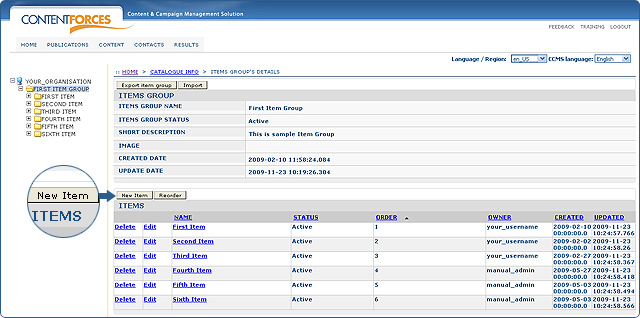
 The system will display a page for creating a new item. You are able to fill in an item's name, select status and choose properties on this page.
The system will display a page for creating a new item. You are able to fill in an item's name, select status and choose properties on this page.
 There are four option in the status dropdown list to choose from:
There are four option in the status dropdown list to choose from:
- New - indicates that the item is currently being created, so till it is approved, it will not be avalaible for publishing
- Acitve - indicates that an item is available for publishing
- Not active - indicates that an item is not avalaible for publishing
- Translate - indicates that an item needs to be translated, and so it is not avalaible for publishing
 Additionally you can see two icons located in the Value field of Properties:
Additionally you can see two icons located in the Value field of Properties:
- IV (Item Variant), which indicates that this property is only assigned to item variants. The value of this property may be changed only when editing item variants
- M (Multilingual), which indicates that the visible value of a property will be the same in every language. For example sizes of T-shirts (such as S, M, L) will be the same in every language.
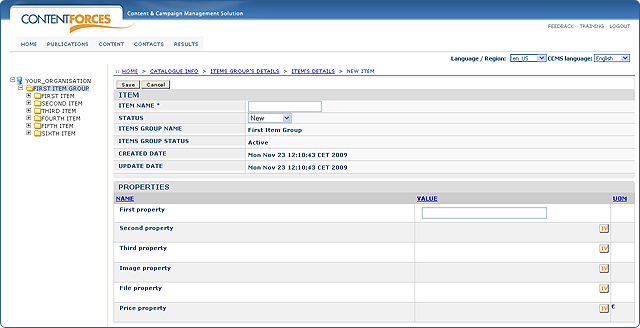
 You should fill in all required information, such as the name of the Item, status and, if there are, properties of it.
You should fill in all required information, such as the name of the Item, status and, if there are, properties of it.
When all changes are approved, click the 'Save' button to save the item. Otherwise click 'Cancel' to discard.
Both buttons are located on the top-right at the main view. A new item will be added to the chosen item group.
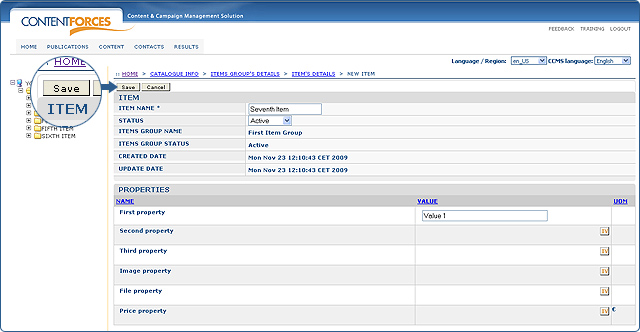
Adding new ITEM Variant
 Adding item variants is realized in the very same way. Click on the 'New Item Variant' button located at the bottom of the item details page (choose items database from the Content tabs menu, then go to a specific item either from the taxonomy tree or Items overview).
Adding item variants is realized in the very same way. Click on the 'New Item Variant' button located at the bottom of the item details page (choose items database from the Content tabs menu, then go to a specific item either from the taxonomy tree or Items overview).
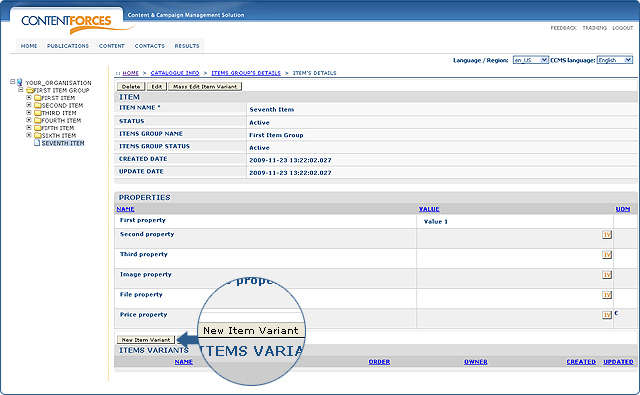
 When creating new Item Variants you may define:
When creating new Item Variants you may define:
- Name of Item Variant
- Status of Item Variant
- Values of properties of Item Variant.
Types of properties depends on agreement you have made with Content Forces (for example check boxes, value lists).
 Additionally, you can see two icons located in the Value field of Properties:
Additionally, you can see two icons located in the Value field of Properties:
- IV (Item Variant), which indicates that this property is assigned only to Item Variants. The value of this property may be changed only when editing Item Variants
- M (Multilingual), which indicates that the visible value of property will be the same in every language. For example sizes of T-shirts (such as S, M, L) will be the same in every language.
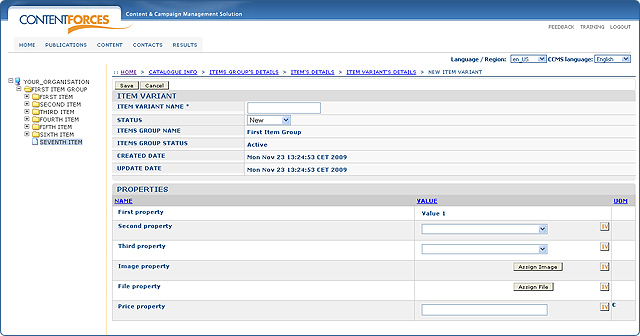
Note, that only values of properties assigned to item variants can be defined when creating new item variants. Other values are defined when creating an item. It means that some properties you can be changed on the item level and some only on the item variant level. Therefore, if you have one item with different color variants, then you can fill in the description on the item level, but you can only change the 'color' property on the variant level.
Input on which properties (specifications) are related to items and which are related to item variants should be delivered by the client before starting the process of Item Management implementation.
 When all changes are approved click the 'Save' button to save changes. Otherwise click 'Cancel' to discard changes. Both buttons are located on the top-right at the main view. Changes will be visible in both, the taxonomy tree (when item navigation will be updated) and in the items details, where variants were added.
When all changes are approved click the 'Save' button to save changes. Otherwise click 'Cancel' to discard changes. Both buttons are located on the top-right at the main view. Changes will be visible in both, the taxonomy tree (when item navigation will be updated) and in the items details, where variants were added.
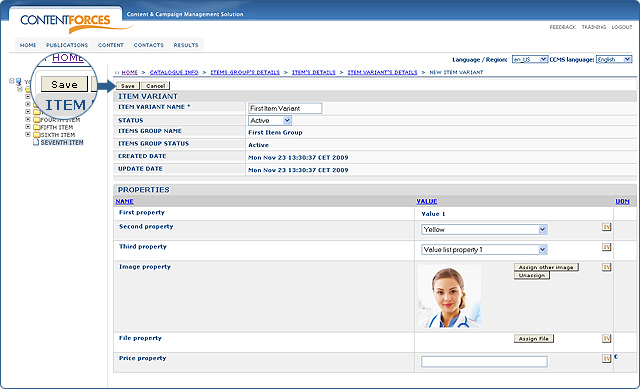
Note, that if your website is multilingual (has different Language/Regions) you should also update data in other languages. To do that, change the Language/Region and edit recently added items/item variants. So you should i.e. insert translations for not multilingual values and change status from 'Translate' into 'Active'.

 Log into the system and choose Items Database from the Content tabs menu. You will be redirected to the overview page of Items.
Log into the system and choose Items Database from the Content tabs menu. You will be redirected to the overview page of Items.

 There are four option in the status dropdown list to choose from:
There are four option in the status dropdown list to choose from:



